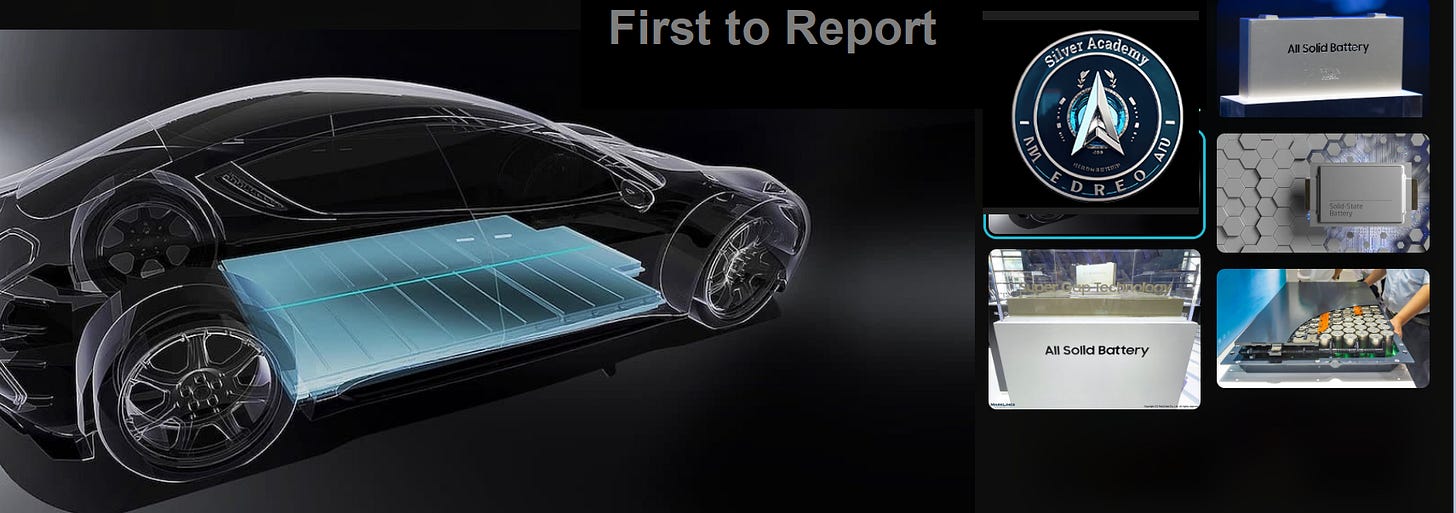Exploring Samsung's Silver Solid State Batteries: Key Insights and Market Impact
Adding Trucks, Buses, Vans, Ships, Barges, Ferries, Yachts and Planes to the Equation.
The comparison between the lithium-ion battery components and the potential use of silver in Samsung's SS batteries reveals some interesting contrasts:
Lithium-ion Battery Components
A typical EV battery weighs around 454 kg (1,000 pounds).
The Tesla Model S battery pack weighs approximately 540 kg (1,200 pounds).
A Tesla Model S battery contains about 62.6 kg (138 pounds) of lithium.
Silver in Samsung's SS Batteries
Only 1 kg of silver is required per vehicle for a 100 kWh capacity battery pack.
This is significantly less weight compared to the lithium content in current EV batteries.
Potential Impact on Silver Demand
If 20% of the 80 million vehicles produced annually adopt Samsung's SS batteries, it would create a demand for 16,000 metric tons of silver per year.
Comparison
Weight: The 1 kg of silver per vehicle is substantially lighter than the 62.6 kg of lithium in a Tesla Model S battery, representing only about 1.6% of the lithium weight.
Resource Efficiency: The silver-based battery appears to require significantly less raw material by weight compared to traditional lithium-ion batteries.
Scalability: While the potential silver demand of 16,000 metric tons annually seems large, it's important to note that this would be spread across 16 million vehicles (20% of 80 million).
Material Diversity: Current lithium-ion batteries require a mix of materials including lithium, cobalt, nickel, and manganese. The silver-based battery might simplify the material requirements.
Economic Impact: The shift to silver-based batteries could potentially reduce reliance on lithium and other materials currently sourced from specific regions, possibly altering global supply chains.
Silver Solid State Battery
Now Add other Vehicles to the Equation
Adding these scenarios to our analysis of Samsung's silver solid-state battery technology reveals even more significant potential impacts on the silver market and transportation industries:
Adoption by Trucks, Buses, and Vans
If larger vehicles like trucks, buses, and vans adopt Samsung's silver solid-state battery technology, the silver demand could increase dramatically:
These vehicles typically require larger battery packs due to their size and weight.
Assuming a 200 kWh capacity for these vehicles (quadruple that of a car), they might require 4 kg of silver per vehicle.
If 10% of the global production of these vehicles (estimated at 20 million annually) adopted this technology, it could add an additional 4,000 to 8,000 metric tons of silver demand per year.
Adoption by Ships, Barges, Ferries, and Yachts
The maritime industry's adoption of this technology could have an even more substantial impact:
Large vessels like ships and ferries might require battery packs in the megawatt-hour range.
A single large ship could potentially use 10-20 kg of silver or more in its battery system.
Even if only a small percentage of the global fleet (estimated at around 100,000 commercial vessels) adopted this technology, it could add thousands of metric tons to annual silver demand.
Adoption by Airplanes
The aviation industry's potential adoption of silver solid-state batteries presents interesting possibilities:
While full electrification of large commercial aircraft is currently challenging, smaller electric aircraft and hybrid-electric systems are being developed.
A mid-size electric aircraft might require a battery pack of several megawatt-hours, potentially using 50-100 kg of silver.
If 1% of the global aircraft fleet (estimated at about 40,000 aircraft) adopted this technology annually, it could add 200-400 metric tons to silver demand each year.
Cumulative Impact
Combining these scenarios with the original estimate for passenger vehicles:
Passenger vehicles: 16,000 metric tons
Trucks, buses, and vans: 4,000 metric tons
Ships and large vessels: 2,000-5,000 metric tons (conservative estimate)
Aircraft: 200-400 metric tons
This could potentially result in a total additional silver demand of 22,200 to 25,400 metric tons annually.
Market Implications
This level of demand would represent 88-101% of the current annual global silver production (approximately 25,000 metric tons).
Such a significant increase in demand could lead to a substantial rise in silver prices, potentially making it one of the most valuable commodities.
The silver mining industry would likely see rapid expansion and increased investment to meet this growing demand.
Recycling of silver from decommissioned batteries could become a crucial industry to support the sustainable use of this resource.
The adoption of this technology across various transportation sectors could accelerate the global transition to electric propulsion, potentially reshaping entire industries and significantly reducing carbon emissions.
This analysis underscores the potentially transformative impact of Samsung's silver solid-state battery technology, not just on the automotive industry, but across multiple transportation sectors and the global silver market.





